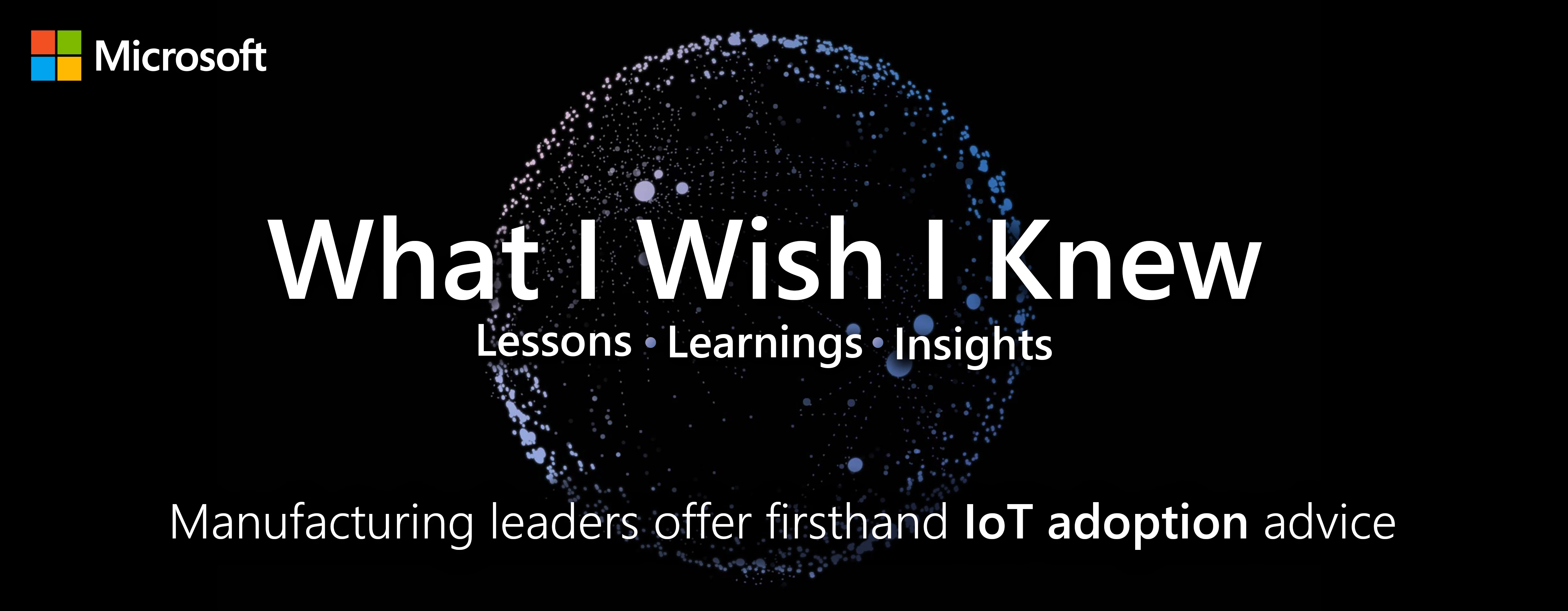
The manufacturing industry’s digital transformation is accelerating as companies increase their use of Internet of Things (IoT) technology to improve efficiency and address common factory challenges. But even if your company makes high-tech products and has a sizable IT team, designing and deploying an IoT solution that creates real improvements in your processes or services isn’t a small undertaking.
To assist, we’re launching the What I Wish I Knew video series, in which manufacturing business leaders share firsthand insights about best practices and common pitfalls to avoid while navigating the setup and deployment of successful IoT solutions—and how they’ve used Microsoft Azure IoT technology to simplify the process.
Adding IoT technology to your manufacturing or industrial operation and expecting immediate results doesn’t just happen without thorough planning. In the words of Scott Gravelle, CEO and chief technology officer of Attabotics, pulling together specific expertise and then integrating the right technology into your operation takes “complexity of orchestration.” Below business leaders share their insights on the possibilities that exist for using IoT in manufacturing, as well as advice for navigating common challenges through proper research, decision-making, and technical expertise.
Emerging trends in manufacturing IoT
IoT is increasingly seen by manufacturers as a necessity to compete. By 2025, 50 percent of industrial enterprises will use industrial Internet of Things (IIoT) platforms to improve factory operations, up from 10 percent in 2020, according to Gartner. Manufacturers surveyed for the latest Microsoft IoT Signals report say industrial automation, production planning, scheduling, and quality and compliance are the top reasons for adopting IoT solutions. Among discrete manufacturers, production flow monitoring is the top reported use.
Remote monitoring and predictive maintenance remain the most common uses of IoT devices in manufacturing, but the onset of COVID-19 further proved the case for using IoT and connected tools that allow for remote operation and automation. IoT networks are evolving into connected ecosystems that allow for operators to gather more data and act on it even if they’re miles away from a factory or office building.
The availability of emerging technologies such as artificial intelligence (AI), smarter edge computing, and digital twins as integral parts of IoT solutions is creating new opportunities for businesses to design innovative solutions. Azure IoT offers these technologies to allow operators to remotely control building systems, equipment, and more through 3D digital models. Combined with intelligent edge computing and AI’s abilities to analyze large amounts of information and images, comprehend speech, and make automated decisions and predictions, it’s possible to create agile, connected factory systems that learn and adjust to maximize operations.
Valuable lessons from others’ IoT adoption
The promise of greater capabilities, more efficiency, and being able to offer customers new services through IoT solutions is real, but the journey toward digital transformation requires taking the right steps from the start. The learnings shared in the What I Wish I Knew video series include what technology decision-makers should consider in the earliest stages.
Have realistic goals and expectations
From the start, says Stuart Bashford, digital officer for the Buhler Group, you should “have a very, very clear understanding of why you're doing this and what you want to achieve.” You need to have specific ideas on how IoT can improve your operation before deciding on platforms and solutions. Getting to that stage requires researching or talking to experts and potential partners about what use cases make sense for your business.
If an IoT pilot project fails, learn from it, and quickly move on, advises Finn Mainstone, senior product manager at Siemens Gamesa. “When you’re developing something that is truly cutting edge and hasn’t been done before, you don’t know exactly how it’s going to turn out.”
Agree on basic standards and technology needs
Discussing standards and fundamental technology needed for your IoT solution is crucial at the start as well, says Sudhi Bangalore, CTO for global operations at Stanley Black & Decker. “I wish we had spent more time on planning those standards better. Because what we’ve had to do in some cases is unwind and go back and fix things because standards were not properly set.”
Similarly, Mainstone adds, locking down technical details from the beginning of a solution development saves time and money in the long run.
Get buy-in from your leaders and employees
Engaging your people from the top executives to the factory floor is as important as the new technology. “We’ve grown to understand and realize that we don’t get anywhere with our digital solutions if we don’t put an equal amount of effort into managing those human relationships as well,” Bashford says. “I hear stories of companies trying to go through a digital transformation without having support at the top, and that must be very hard.”
Francisco Sanchez, CIO at Fermax, recommends investing in training and getting employees at all levels interested in and excited about adopting IoT technology. While many of his technology team members didn’t have deep knowledge of IoT and cloud capabilities when they started planning their solutions, he says it was gratifying to see how willing they were to learn.
Learn more about Azure IoT adoption and solutions
The What I Wish I Knew video series offers countless insights on streamlining IoT adoption, potential challenges, and how digital transformation can improve manufacturing operations, from creating connected factories, to bringing better supply chain visibility, and engaging customers in new ways. More details about Azure IoT products and services that can transform manufacturing will be highlighted by Microsoft at the annual Hannover Messe event, April 12-16, 2021.
Additionally, the Azure Industrial IoT page offers insight into how our IoT platform can power manufacturing-specific solutions, while the Azure IoT overview gives a wider view of the technology’s possibilities.
